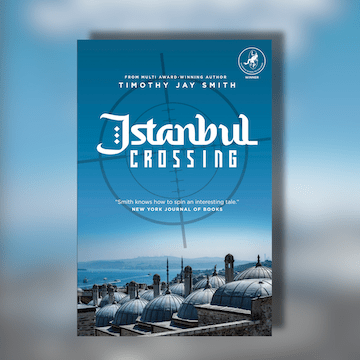 Ariel S Winter’s first novel The Twenty-Year Death is bound to appeal to fans of the mid-20th century noir and hardboiled crime fiction we often cover on the site. Formerly a librarian, a bookseller and even a pie man, he’s now the published author he wanted to become. And The Twenty-Year Death sounds like a massive accomplishment. It’s written in three books – one in the style of Georges Simenon, one like Raymond Chandler, and one mimicking Jim Thompson – to tell an overarching story. Quite a feat for your first novel, so we had to ask him about it…
Ariel S Winter’s first novel The Twenty-Year Death is bound to appeal to fans of the mid-20th century noir and hardboiled crime fiction we often cover on the site. Formerly a librarian, a bookseller and even a pie man, he’s now the published author he wanted to become. And The Twenty-Year Death sounds like a massive accomplishment. It’s written in three books – one in the style of Georges Simenon, one like Raymond Chandler, and one mimicking Jim Thompson – to tell an overarching story. Quite a feat for your first novel, so we had to ask him about it…
Why did you decide to write three novels in one book?
I wrote Book One: Malniveau Prison, a Simenon pastiche, as part of another book that fell apart. As I reworked it, I started to think, what would a crime series that followed a secondary character instead of the detective look like? Once I picked the writer Shem Rosenkrantz as the through character, the natural progression of his life led me to Chandler’s Hollywood. And once I had Simenon in 1931 and Chandler in 41, Jim Thompson was the obvious choice for the last section, set in 51.
So who’s in each of the stories and what happens?
In Book One: Malniveau Prison, Chief Inspector Pelleter travels to the provincial town Verargent to visit a prisoner at Malniveau Prison who has demanded an audience. At the same time, an anonymous murder victim is discovered on one of Verargent’s back streets. As it becomes clear that the two things are connected, Pelleter digs into the prison and the town’s past to discover a terrible cover-up. Along the way, he meets the murder victim’s daughter, Clothilde Rosenkrantz, and her husband, the American writer Shem Rosenkrantz, a popular and critically acclaimed author at the height of his powers.
Then in Book Two: The Falling Star, Clothilde Rosenkrantz has become the Hollywood screen star Chloë Rose. Shem Rosenkrantz is now an alcoholic screenwriter and philanderer. When Chloë Rose becomes convinced she is being followed, the studio hires private detective Dennis Foster to act as babysitter. They think Rose, who has already started to show signs of coming unhinged, is just crazy. Then Rose’s co-star, also Rosenkrantz’s mistress, turns up murdered, and Rose finds herself a suspect. Foster decides it’s his duty to clear Rose’s name, which begins to unravel a conspiracy at the highest levels in Hollywood.
Finally, in Book Three: Police at the Funeral, Shem Rosenkrantz has fallen so far that he can’t get a thing published, can’t get work as a screenwriter, and is at the end of his money. Clothilde has been permanently hospitalised, and Rosenkrantz has formed a tempestuous life with a glorified prostitute Vee. When Rosenkrantz’s first wife dies, he returns to the East Coast for the reading of the will. It turns out he’s second in line for her family fortune behind his estranged son. Will he be able to make it up with his son, who blames him for every ill in his life? The answer leads to a widening spiral of violence that has only one logical conclusion.
Why did you choose to write in the voices of Simenon, Chandler and Thompson?
The original novel I set out to write was to be a sort of Cloud Atlas by way of WG Sebald. The frame narrative was about a man sitting and reading, and the reader would get to read in full whatever books the main character read. I was reading a lot of Simenon at the time, and it seemed like something I could do, so I wrote a Simenon. As the book began to turn into The Twenty-Year Death, I thought it appropriate to finish with other pastiches, and as an enormous Chandler and Thompson fan, those were the first two I went for. That they were each the respective master of his decade solidified the choice.
Do any characters these guys created appear?
Nothing in The Twenty-Year Death comes directly from Simenon, Chandler, or Thompson. No clever cameos or even settings (aside from Hollywood, which was a requisite of the story whether Chandler was involved or not). I tried to remain faithful to the authors while being wholly original.
What characteristics of their writing styles did you try to capture?
The trick of capturing such stylised writers is to emulate their tone and the way they construct a story. Maigret in the Simenon novels is a silent, self-assured analytic mind. The cases open up for him, because they must. A clue will present itself because he is looking, waiting for it, often contriving situations that will force clues to be revealed, and eventually the clues will lead to the answer. Chandler’s Marlowe, on the other hand, flails about, external events happening to him, and he’s there to crack wise, provide a moral compass, and hope he’s not dead when the last mystery is unraveled. And Jim Thompson’s narrators are crazy, beaten, raging, vicious people who assault the reader as much as they assault their own worlds. They are the perpetrator. And it’s never their fault.
You used to be a bookseller, and now you’ve written a book that’s been praised by no less than Stephen King. How does it feel and how much has your life changed?
The biggest change is a sense of self-assurance and vindication. I was a bookseller, or working at a publisher, or in a library. All of my day jobs were book related, save working as a pie man, which is another story. I was always a writer. The other jobs were a means to an end. I had to work to pay the bills, but when I wasn’t at work, I wrote, knowing that writing was my true career. Of course, as the year’s passed, the fear grew that it would never happen, and all the naysayers would get to use the “I told you so” I’d been saving. As for the praise that’s been heaped on the book, I just feel so fortunate. I could never have hoped for King or any of the others to support me like they have.
Watch for the Crime Fiction Lover review of The Twenty-Year Death soon.








